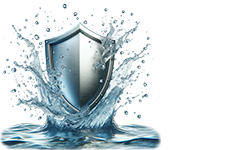Okay, let’s talk about water. That stuff we drink every single day, feels like second nature, right? Turn the faucet, fill a glass, down the hatch. Simple. But have you ever really thought about where it’s been? Like, its whole life story before it got to you? It sounds a bit dramatic maybe, but stick with me here. This clear liquid, essential, absolutely vital… it might be carrying secrets. Hidden baggage from its journey. Think about it – miles of pipes, some ancient, treatment plants doing their best (hopefully!), but is it ever truly… pristine? That clarity can be deceiving, a bit of a magic trick, hiding stuff we’d probably rather not swallow. It’s not about paranoia, more like… informed curiosity? Yeah, that sounds better.
Imagine that water starting its trip. Maybe way up in some reservoir, looking clean, then whoosh – into the system. Miles and miles underground, snaking through pipes that have seen decades pass. Generations, even. Like old arteries, you know? Carrying the lifeblood of the city, but maybe picking up little bits of plaque along the way. Residues, minerals dissolving, maybe stuff leaching from the pipe material itself – who knows what’s down there, really? And yeah, municipal treatment plants exist, they zap it with chlorine, filter out the big chunks. But are they catching everything? Those news reports you sometimes hear, about infrastructure problems or boil advisories up here near New Windsor or anywhere, really… they’re reminders that the system isn’t foolproof. It’s like expecting a highway patrol car on every single mile of road, 24/7. Stuff slips through. Tiny invisible things.
And our bodies? Incredible machines, honestly. But they run on the fuel we give them. Water is fundamental, obviously. Hydration keeps the gears turning, thoughts clear (mostly!), energy up. But what if the fuel isn’t quite pure? It’s maybe not like drinking poison, not usually that dramatic. Think more like… putting slightly dirty oil in your car. It still runs, sure. But over time? It puts a strain on things. Makes the engine work harder, wear down faster maybe? Our bodies are resilient, thank goodness, but constantly processing extra gunk, even tiny amounts, well, it’s just more work. It’s this slow-burn stress on our internal systems. We deserve better fuel, don’t you think? Purity isn’t just a fancy word; it’s about giving our bodies the clean slate they need to thrive. Makes sense.
We all kinda assume tap water = safe water. It’s regulated! And that’s true, there are standards. Minimum standards, though. Sometimes you gotta wonder if the minimum is really enough, especially long-term. Plus, think about all the stuff they don’t test for regularly, or new things like microplastics that are everywhere now. It’s like, the rulebook was written ages ago, and the world keeps changing. Remember seeing those articles about forever chemicals? Scary stuff. And even if everything is technically “below the limit,” what happens when you mix a cocktail of five different things all below their own limits? Does anyone really know? It feels like a bit of a gamble, trusting that the bare minimum is genuinely protecting our health deep down. I read somewhere – can’t recall exactly where, maybe online – that a surprising percentage of water systems have some kind of violation each year. Minor, maybe, but still… makes you pause.
Okay, deep breaths. Feeling a little stressed reading this? I get it. It’s unsettling! But knowledge isn’t meant to paralyze, it’s meant to empower. That’s the goal here. Instead of just passively accepting whatever comes out of the tap, what if you took back control? Right there in your own kitchen. Like putting a bouncer at the door, deciding who gets in. Imagine that feeling – knowing, really knowing, that the water you’re drinking, cooking with, giving to your kids or pets, is genuinely clean. That uncertainty? Gone. Replaced by this quiet confidence. It’s a powerful shift, moving from “I hope it’s okay” to “I know it’s clean because I made sure.” That’s not anxiety, that’s peace of mind. Big difference.
And the difference clean water makes… sometimes it’s obvious, like the taste. No more vaguely swimming-pool flavor from chlorine. Just… water. Crisp, refreshing. Suddenly drinking enough water doesn’t feel like a chore, it feels good. Like your body just sighs in relief. Cooking tastes better too – the real flavors come through. Coffee! Oh man, good water makes amazing coffee. But it’s more than just taste buds. It’s that deeper feeling, knowing you’re dodging those little chemical bullets, giving your body the pure H2O it actually needs. It’s like upgrading from dial-up internet to fiber optic – everything just works better, smoother. It feels cleaner, lighter. More alive? Maybe that’s too much, but it definitely feels better.
So how do you get this magic clean water? Filtration, basically. There are different kinds – some stick on your faucet, some go under the sink, whole-house systems… it’s a whole world. But the basic idea is putting a barrier between the municipal supply and your glass. Think of it like a super-fine sieve, or maybe a chemical magnet, grabbing onto the gunk you don’t want. Activated carbon filters are common, great for chlorine taste. Reverse osmosis is more intense, pushes water through a membrane that blocks almost everything else. It’s technology working for your well-being, right there in your home. Quietly, reliably making things purer. No fuss, just clean water on demand. It’s pretty amazing when you think about it.
And don’t just think drinking water! What about washing lettuce? Boiling pasta? That water gets absorbed, becomes part of your food. Even showering – you breathe in the steam, your skin soaks it up. It’s all exposure. So having cleaner water everywhere in the house starts to make a lot of sense. It’s not just about the glass you drink, it’s about reducing your overall load, creating a healthier little bubble for yourself and your family. A sanctuary, yeah? Where you control the quality of this essential thing.
Choosing to filter your water, it feels… responsible. Like you’re investing in your future health, your family’s safety. It cuts through the noise and worry about aging infrastructure (which, let’s be honest, seems like a constant news topic these days) and gives you something tangible you can do. It’s that basic instinct kicking in – protect your own. In a world that feels increasingly complicated and full of things we can’t control, managing your water quality is something you can. And that feeling? That security? Honestly, it’s priceless. You can’t put a price tag on knowing you’re doing the best you can for your body’s foundation.
Water. It connects everything. Flows through everything. Life’s solvent, right? Giving it a little thought, ensuring its purity in our own homes… it feels less like a chore and more like an act of profound self-respect. Or maybe just common sense in a complex world. As you go about your day, maybe just notice the water you use. Think about its journey. Think about yours. What small change could bring a greater sense of well-being, a deeper trust in the very element that sustains you? Something to ponder, anyway. The choice, thankfully, is yours to make.

